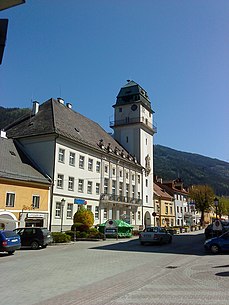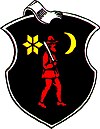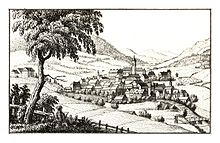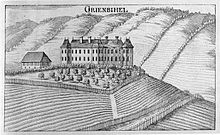Rottenmann
|
Borough Rottenmann
|
||
|---|---|---|
| coat of arms | Austria map | |
|
|
||
| Basic data | ||
| Country: | Austria | |
| State : | Styria | |
| Political District : | Liezen | |
| License plate : | LI | |
| Main town : | City of Rottenmann | |
| Surface: | 205.33 km² | |
| Coordinates : | 47 ° 32 ' N , 14 ° 21' E | |
| Height : | 681 m above sea level A. | |
| Residents : | 5,160 (January 1, 2020) | |
| Postal code : | 8786 | |
| Area code : | 03614 | |
| Community code : | 6 12 63 | |
| NUTS region | AT222 | |
| Address of the municipal administration: |
Hauptstrasse 56 8786 Rottenmann |
|
| Website: | ||
| politics | ||
| Mayor : | Alfred Bernhard ( ÖVP ) | |
|
Municipal Council : ( 2020 ) (25 members) |
||
| Location of Rottenmann in the Liezen district | ||
 town hall |
||
| Source: Municipal data from Statistics Austria | ||
Rottenmann is a mountain town with 5160 inhabitants (as of January 1, 2020) in the federal state of Styria ( Austria ). The city is located in the Rottenmanner Tauern and in the Paltental , of which Rottenmann is the main town. Rottenmann is also the oldest town in the district and one of the oldest in Austria.
The city is known, among other things, for its historic old town and the headquarters of AHT (Austria Haustechnik). Sights are on a monumental rock towering castle Strechau in the municipal area of the neighboring village of Lassing, the castle Grünbühel , Castle Thalhof and (former "The Castle" Augustinian Canons ) is in the old town. The steeple of the parish church Rottenmann was for a time the highest of Styria.
geography
Geographical location
The town center of Rottenmann is at 681 m. The Palten flows through the village . Rottenmann is the namesake of the Rottenmanner Tauern and the capital of the Paltental . The peaks in the Rottenmann municipality are the local mountain Stein am Mandl , Hochhaide , Moserspitz, Diewaldgupf, Seegupf, Dreistecken , Plannereck and a few others in the Rottenmanner Tauern and the Dürrenschöberl in the northern Eisenerzer Alps . The city is located at the western end of the Palten-Liesing valley and is one of the three main towns.
Two rivers originate in the municipality of Rottenmann: the Gulling , which flows into the Enns via the Gullingtal , and the Strechenbach , one of the larger tributaries of the Palten , which flows over the Strechen valley and the Rottenmanner Klamm into the Paltental.
The area of the municipality is 205.33 km² and is therefore the tenth largest municipality in Styria and the fifth largest in the Liezen district. The municipality of Rottenmann is located at an altitude of 622 m above sea level. A. and 2448 m above sea level A. ( Big Evil Stone ). Rottenmann is about ten kilometers from the district capital Liezen and the third largest city in the district in terms of population (after Liezen and Schladming ).
Community structure
The municipality is divided into 13 towns (population in brackets as of January 1, 2020):
- Bärndorf (241) including the Outer Sonnberg, Hallweg and Innerer Sonnberg
- Boder (548)
- Bruckmuehl (732)
- Büschendorf (234) including Büschendorf-scattered houses
- Edlach (86) including Hinterberg, Poderer and Poierer
- Klamm (104)
- Oppenberg (239) including Gulling, Rohrach, Vorberg and Winkel
- Rottenmann (2160) including the castle gate settlement and urban forest settlement
- Sankt Georgen (241) including Sankt Georgen-Dispersed Houses, Scheibenboden and Schindlhof
- Singsdorf (181) including Einöd, Gstatthof and Sand
- Strechau (159)
- Stretching (9)
- Villmannsdorf (226) including Goldbichl, Grünbichl and Villmannsdorf-Scattered Houses
The community consists of six cadastral communities (area: as of December 31, 2018):
- Bärndorf (1,194.24 ha)
- Büschendorf (145.35 ha)
- Edlach (736.74 ha)
- Oppenberg (9,284.96 ha)
- City of Rottenmann (8,018.07 ha)
- Singsdorf (1,168.32 ha)
Incorporations
- 1850: St Georgen , Strechau and Strechen
- 1943: Villmannsdorf and Büschendorf
- 1974: Municipality of Palten ( Bärndorf , Singsdorf and Edlach )
- 2015: Oppenberg (as part of the Styrian community structural reform ), the new community continues the name Stadtgemeinde Rottenmann. The basis for this is the Styrian Municipal Structural Reform Act - StGsrG.
Neighboring communities
In the north Rottenmann borders on Selzthal and Admont , in the east on Trieben , in the south-east on Hohentauern ( Murtal district ), in the south on Pölstal , in the south-west on Irdning-Donnersbachtal and Aigen im Ennstal and in the west on Lassing ; seven of the eight neighboring communities are in the Liezen district.
| Lassing | Selzthal | Admont |
| Aigen in the Ennstal |

|
Shoots |
| Irdning-Donnersbachtal | Pölstal | Hohentauern |
history
Due to its millennia-long history, Rottenmann is nicknamed the “Millennial Mountain City”.
10th to 15th centuries
Rottenmann was first mentioned in a document around 927 in an exchange document concluded between the Archbishop of Salzburg and his choir bishop Cotabert.
The original Rottenmann was about a kilometer further east in today 's St. Georgen district . Since there was no further expansion of the settlement possible due to the geological conditions (heavy swamp), today's location was planned by a German town planner on the rubble slopes of the local mountain "Stein am Mandl" in the south of the city.
In order to protect the merchants who used the heavily frequented salt and trade route - formerly the Roman route - Rottenmann Castle was built at the beginning of the 12th century at the latest and surrounded with walls and moats. From this, today's Rottenmann developed over the years with a wide market street (market place), from which narrow streets branch off at right angles.
The parish church of St. Nicholas is mentioned for the first time around 1266. Until then only as a branch church of Lassing . On October 25, 1279, King Rudolf von Habsburg stayed in Rottenmann for the first time and was likely to have carried out the town elevation during his visit, as Rottenmann was repeatedly referred to as town in various documents in the following years. This makes Rottenmann one of the oldest cities in Austria. The oldest mention of a city judge is recorded in 1296.
Around Rottenmann, today's districts of Singsdorf and Strechau around 1080, Büschendorf around 1135, Bärndorf around 1150, Grünbühel around 1190, Villmannsdorf in 1296 and Goldbühel in the 15th century are mentioned for the first time.
After Rottenmann in 1251 of Salzburgian had been occupied troops, this happened again in 1292, when the Styrian nobility covenant - with Salzburg and Bavaria ally - against Duke Albrecht I rebelled. Soon afterwards (1320) the town charter was confirmed for the loyalty to the sovereign, and at the same time Rottenmann received extremely important and lucrative trade, market and court freedoms; Especially the right to iron and salt deposition and the high income from the nearby silver mines of Oppenberg and Dietmannsberg quickly made the Rottenmann citizens wealthy.
In 1453 the Rottenmann citizen Wolfgang Dietz donated money for the construction of a monastery, after approval by Pope Calixt III. were Augustinian canons from Vienna called to Rottenmann. However, the monastery did not have a really great future, especially during the Reformation it suffered heavily. Emperor Joseph II finally abolished the monastery in 1785. The Rottenmann monastery was later acquired by Eisengewerke Pesendorfer, later by Max Ritter von Gutmann , who sold it to the industrialist Flick when Austria was annexed to the German Empire .
16th to 18th century
The 16th century was marked by the spread of Lutheranism and the resulting disputes and unrest. The barons Hoffmann proved to be decisive promoters of the new faith and soon dominated the entire Paltental and areas beyond. In the course of the subsequent Counter-Reformation, a reform commission was sent to Rottenmann on November 15, 1599 by order of the sovereign - two days later the Evangelical Salvator Church, built only twenty years earlier, was reduced to rubble. As a result of the emigration of Lutheran-minded people, Rottenmann only had 116 citizens in 1612, and at that time only those residents were referred to as citizens who could prove that they owned a house within the city walls.
19th century
After the city was occupied twice by French troops, which led to famine and catastrophic conditions, an improvement occurred when Josef Pesendorfer took over iron processing in 1815.
In 1892 the Lapp brothers took over the iron works in Rottenmann and modernized the company. After the Second World War , the plant was continued as Paltenstahlwerk Rottenmann and finally bought by the German industrialist Bauknecht . Today cooling devices are manufactured here by AHT .
From 1849 to 2002, after Rottenmann had its own jurisdiction for centuries, the district court existed. In 1850 St. Georgen, Strechau and Strechen were incorporated.
20th century
Between 1912 and 1914 the town hall was built by the architect Josef Hofbauer .
In 1943 the districts of Villmannsdorf and Büschendorf were incorporated. On January 1, 1974, the municipality of Palten with the districts of Bärndorf, Edlach and Singsdorf was united with the municipality of Rottenmann.
21st century
Between 2000 and 2017, the Rottenmann University Center was a branch of the Graz University of Technology and the Johannes Kepler University in Linz . In 2017 it was decided to close the UZR. The premises were taken over by the Caritas educational institution for social professions. The current location of the Caritasschule in the old town will, however, still be managed.
On July 1, 2002, the Rottenmann judicial district , consisting of the municipalities of Rottenmann, Lassing , Trieben , Oppenberg , Selzthal , Treglwang and Gaishorn am See , was dissolved and assigned to the Liezen judicial district .
In the summer of 2013, a house in the city center was demolished, whereupon the wall of the neighboring Lindmayr building, which was directly attached, partially collapsed a few days later. Since then there has been a gap in the middle of the city center next to the town hall. On July 3, 2017, after almost four years, a decision was made on how to fix the "hole" again. In 2018, the reconstruction of the two houses began.
Population development

The name Rottenmann
Rottenmann originally had four names. There are four names on the wall of the council chamber of the town hall: Tartusana, Stiriate, Castra Montana and Cirminah .
One story has it that there was a dragon slayer who was called "Red Man" by the blood of the dragon. More likely, however, is the possibility that the name “Rottenmann” cannot be traced back to this legend, but that the legend is based on the place name. The explanation that “Rottenmann” should normally be called “Rotenman” sounds much more credible. The double spelling can be traced back to various poets and writers who simply decorated the names with double letters. “Rotenman” would mean something like “The border at the swamp”. ( Back then, red meant swamp, you meant the border.) A pretty credible explanation when you consider that the entire Paltental was a pure swamp area after the Ennstal Glacier melted.
In this way, several meanings are ascribed to the name Rottenmann. Some can be traced back to mystical considerations, others have a linguistic or historical basis or old spellings.
For the thesis that it is about the color, there is a well-known quote from 1048: "prediolum Rotenmannun dictum ... sclavonice etiam Cirminah nominatum" (German: the Rottenmann estate ... also called Cirminah in Slavonic ). This shows, on the one hand, that Slavs and Bavarians lived together for centuries throughout Styria, and on the other hand, it is proof that Rottenmann is a translation of the Slavic Cirminah ( črmljen = among the Reds). It is therefore possible that an original settler actually wore red hair or was otherwise associated with the color red.
Another simple explanation would be to attribute the name to a clearing activity , a cleared area.
Culture and sights
- Church in St. Georgen in Alt-Rottenmann: The church of St. Georgen was built in 1042 as the first Rottenmann parish church (hence the name Alt-Rottenmann) in the Romanesque style. Renewed consecration in 1313 by Bishop Heinrich von Gurk after it was destroyed by the Turks and Tatars. Extensive renewed destruction in August 1480 by the Turks, then rebuilt. Gothic maybe as early as 1414, a window still reminds of the once Romanesque style. Re-consecrated on June 13, 1513 by the Chiemsee Bishop Berthold Pürstinger, who also consecrated the churches of Lassing and Gaishorn am See at that time . The late Gothic high altar was created around 1520 by the workshop of Lienhart Astl (Leonhard Aist) from Gmunden. The positive organ from 1722 is also worth mentioning. Up until the 1950s, St. Georgen was the destination of pilgrims from the neighboring parishes (Lassing is documented), who held a procession on St. George's Day to Rottenmann .
- Catholic parish church Rottenmann hl. Nikolaus: The first church was built by the city in the first half of the 13th century, financed by the income from the road toll. At that time still called as a branch church of Lassing. In 1439 the Rottenmann citizen Wolfgang Dietz donated “a lot of money” for a new church building. In 1480, St. Nikolaus became the provost church of the newly founded Augustinian Canons Foundation. Today's church was built by the church builder Christoff Marl. The oldest frescoes in the parish church date from 1509–1513. All frescoes were whitewashed at the latest during the renovation in 1884 (year on the pulpit), and exposed again during the renovation in 1953.
- Like many churches in the Enns and Paltental, the Chiemsee Bishop Berthold Pürstinger consecrated four altars in the choir room as suffragan bishop for the Archdiocese of Salzburg . All of these altars were replaced by contemporary ones in the Baroque period: The pulpit made of Salzburg red marble is also remarkable, with the provost's coat of arms with the three St. Nicholas balls on it. The baroque sound cover was removed in 1953.
- Also worth mentioning is the late Gothic prayer chair, the Emperor Friedrich III. († 1493) and his wife Eleanor of Portugal, the parents of Emperor Maximilian I , who often stayed in Rottenmann, is dedicated.
- Two of the members of the Hofmann von Grünbühel family can be found on tombstones in the church . The gravestone on the left is that of a Hofmann, the one on the right that of Rosina Hofmann, born in 1577. von Polheim , second wife of Adam Hofmann. On the outside wall there is a tombstone of the Mosheim family from the Reformation period.
- During the big city fire in April 1881, the church tower, which until then had a tent-like roof, about 65 meters high, burned; thanks to the neo-Gothic structure, it then reached a total height of 87.8 meters - measured from street level to the Kreuzspitze - and was so for a short time to the highest in Styria. However, only for ten years, in 1891 he was replaced by the Grazer Herz-Jesu Church with 109.6 meters.
- Former Rottenmann Abbey of the Augustinian Canons
- Bürgerspitalkirche Maria am Rain: Built for the Bürgerspital, founded in 1536 by Johann Christoph von Rappach , in the so-called “Salzburg suburb”. At the end of the 19th century it was fitted with a neo-Gothic tower spire.
- Grünbühel Castle : Grünbühel Castle, also known as Grünbichl Castle, is located north of the town of Rottenmann in the Villmannsdorf district. The castle is a gloomy, elongated building with corner projections. There are rooms with stucco ceilings from the 17th century. The chapel was renewed at the end of the 17th century.
Economy and Infrastructure
traffic
- Rail: The Stadt Rottenmann stop, like the Rottenmann depot, is on a section of the Rudolfsbahn .
- Road: Rottenmann is on the Pyhrnautobahn or E57 and the Schoberpassstraße B 113.
Established businesses
The Rottenmann University Center was located between 2000 and 2017 . The company JoWooD Productions was also known .
Public facilities
Until 2002 there was a district court in Rottenmann. It came into effect with the creation of the Rottenmann judicial district in 1849. Until this came into force, Rottenmann had its own jurisdiction for centuries. In July 2002 the judicial district was dissolved and assigned to the Liezen judicial district.
- LKH Rottenmann-Bad Aussee
- Nursing home Rottenmann run by Caritas in the Graz-Seckau diocese
education
In the municipality of Rottenmann there is a municipal kindergarten, a kindergarten in the state hospital, one in Bärndorf and one in Oppenberg, as well as a day nursery. Primary schools are available in Rottenmann and Bärndorf, as well as a new middle school and a teaching institution for social professions of the Caritas of the Diocese of Graz-Seckau. There is also a central polytechnic school and two music schools.
politics
The municipal council has 25 members.
- With the municipal council elections in Styria in 2000, the municipal council had the following distribution: 16 SPÖ, 5 ÖVP and 4 FPÖ.
- With the municipal elections in Styria in 2005 , the municipal council had the following distribution: 16 SPÖ, 6 ÖVP and 3 FPÖ.
- With the municipal elections in Styria in 2010 , the municipal council had the following distribution: 12 SPÖ, 6 We for Rottenmann - Independent List H. Schaupensteiner, 5 ÖVP, 1 FPÖ and 1 Greens
- With the municipal council elections in Styria 2015 , the municipal council had the following distribution: 11 SPÖ, 7 ÖVP, 5 list WIR, 1 FPÖ and 1 Greens.
- With the municipal council elections in Styria 2020 , the municipal council has the following distribution: 13 SPÖ, 8 ÖVP, 3 WIR and 1 KPÖ.
mayor
- until 2010 Ludwig Kopf (SPÖ)
- 2010–2013 Ewald Persch (SPÖ)
- 2013–2015 Klaus Baumschlager (SPÖ)
- since 2015 Alfred Bernhard (ÖVP)
Personalities
- Karl Auer (* 1959), founder of Auer PR and chairman of the "Global Family Charity Resort" association
- Josef Horn (* 1947) politician and member of the National Council
- Günter Bauknecht (* 1935), entrepreneur (son of Gottlob Bauknecht )
- Christian Feichtinger (* 1948), head of the European Space Agency (ESA) office in Moscow
- Anita Fleckl (* 1967), SPÖ politician , member of the National Council 2002–2008
- Friedrich Karl Flick (1927–2006), entrepreneur and billionaire of German origin, resides in Rottenmann - in the Strechen
- Peter Gruber (* 1955), Austrian writer
- Lukas Hasler (* 1996), organist
- Siegfried S. Hecker (* 1943), director of the Los Alamos National Laboratory 1986–1997, grew up in Rottenmann until 1956
- Max Hinsche (1896–1939), German taxidermist , trapper , scientist and writer , died and buried in Rottenmann
- Ernst EP Hochsteger (* 1947), entrepreneur and chairman of the UZR support association
- Bernhard Hüttenegger (* 1948), Austrian writer
- Franz Krahberger (* 1949), author and founder of Electronic Journal Literatur primary
- Ildefons Lidl , Catholic clergyman and author in the late 18th century.
- Meinhard Lesjak (* 1948), founder of the BauPilz Group
- Rudolf Marchner (1893–1980), politician of the SPÖ , member of the National Council 1945–1959
- Edward J. Oleschak (* 1959), film producer in Hollywood , Los Angeles
- Anton Neußl (1892–1965), born in Rottenmann, Austrian painter and graphic artist
- Michael Ostrowski (* 1973), Austrian actor
- Ewald Persch (* 1964), politician of the SPÖ , member of the Styrian state parliament since 2005
- Marion Pichler (* 1983), founder of the aid project "Spring of Hopes" in South India
- Brunhilde Plank (1956–2001), SPÖ politician , member of the National Council 1999–2001
- Hans Sigl (* 1969), actor (including SOKO Kitzbühel, Der Bergdoktor), dancer, singer
- Gabriel Strobl (1846–1925), priest of Admont Abbey and entomologist
- Hans Sünkel (* 1948), Rector of the Graz University of Technology
- Tamara Tippler (* 1991), ski racer
- Rudolf Tyrolt (1848–1929), castle actor
- Gerhard Urain (* 1972), cross-country skier
- Paul Weiland (1949–2015), Evangelical Lutheran theologian
- Hans-Peter Weingand (* 1964), author and recipient of the GALA 2008 award
- Johann Wöhr (1865–1896) Canon in Graz, writer under the pseudonym Hans Wiesing
literature
- Josef Pfau: “1000 years of Rottenmann. Festschrift for the city's millennium. "Ed. Stadtgemeinde Rottenmann 1952.
- Ingrid Schubert: Rottenmann. In: Oesterreichisches Musiklexikon . Online edition, Vienna 2002 ff., ISBN 3-7001-3077-5 ; Print edition: Volume 4, Verlag der Österreichischen Akademie der Wissenschaften, Vienna 2005, ISBN 3-7001-3046-5 .
- Franz Wohlgemuth: "History of the Parish Gaishorn and the Paltental." Roman Catholic. Gaishorn rectory, Gaishorn 1955.
- Karl Weiß: "Rottenmann: From the first settlement to the double-track expansion of the railway line." Ed. Stadtgemeinde Rottenmann 1995.
- Karl Weiß: "University town of Rottenmann, departure into the 3rd millennium, tradition, achievement, progress." Ed. Stadtgemeinde Rottenmann 2000.
Web links
- 61238 - Rottenmann. Community data, Statistics Austria .
- www.rottenmann.at Website of the municipality of Rottenmann
- Website of the Rottenmann University Center
- Steiermark360, 360 ° panorama Rottenmann (aerial view)
Individual evidence
- ↑ de-at.topographic-map.com. Retrieved March 2, 2020 .
- ↑ Statistics Austria: Population on January 1st, 2020 by locality (area status on January 1st, 2020) , ( CSV )
- ↑ CSV file from REGIONALINFORMATION.zip (1,221 kB) ; accessed on January 12, 2019
- ^ Styrian municipal structural reform .
- ↑ Section 3, Paragraph 6, Item 3 of the Act of December 17, 2013 on the reorganization of the municipalities of the State of Styria ( Styrian Municipal Reform Act - StGsrG). Provincial Law Gazette for Styria of April 2, 2014, No. 31, year 2014, ZDB -ID 705127-x , p. 3.
- ^ Franz Brauner, Steirische Heimathefte , Heft 9, Leykam, Graz 1952
- ↑ Fritz Frhr. Lochner von Hüttenbach: On the name property of the early Middle Ages in Styria (= magazine of the Historical Association for Styria . Volume 99 ). Böhlau Verlag, Vienna 2008, p. 41 ( historerverein-stmk.at [PDF; 16.9 MB ]).
- ↑ Federal Law Gazette II No. 82/2002 : "Ordinance of the Federal Government on the amalgamation of District Courts and the Sprengel of the remaining District Courts in Styria (District Courts Ordinance Styria)"
- ^ Caritas Styria, offers, nursing homes. Retrieved June 21, 2019 .
- ^ City of Rottenmann, Life in Rottenmann, Education & Culture. Retrieved June 21, 2018 .
- ^ Election result of the local council election 2005 in Rottenmann. State of Styria, March 13, 2005, accessed on July 25, 2020 .
- ^ Election result of the local council election 2010 in Rottenmann. State of Styria, March 21, 2010, accessed on July 25, 2020 .
- ^ Election result of the 2015 municipal council election in Rottenmann. State of Styria, March 22, 2015, accessed on July 25, 2020 .
- ↑ Results of the local council election 2020 in Rottenmann. State of Styria, June 28, 2020, accessed on July 25, 2020 .











